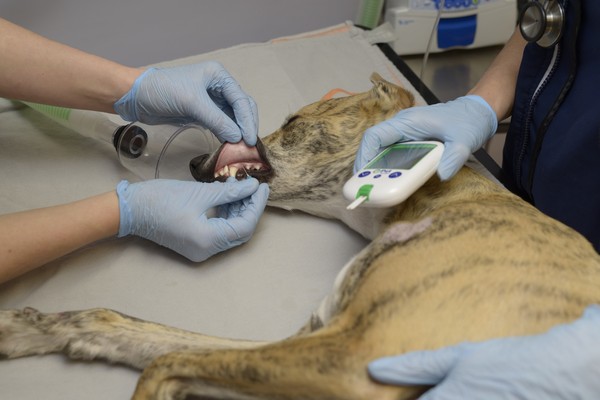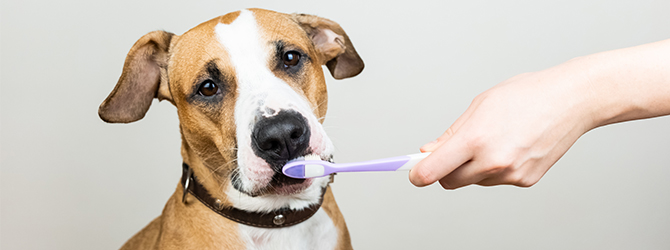How to get rid of bad breath in dogs
Bad breath, also known as halitosis, is a common issue in dogs and may indicate underlying health problems.
It’s often due to dental issues, but it can also be a sign of gastrointestinal disorders or serious health conditions like diabetes, kidney, or liver disease.
Studies show that 48% of dog owners say their pet suffers from bad breath.
Why does my dog have bad breath?
Dogs usually get bad breath when bacteria in their mouths break down proteins, creating unpleasant-smelling compounds like hydrogen sulphide and methyl mercaptan. These are often referred to as volatile sulphur compounds (VSCs).
The most common causes of bad breath in dogs include:
- Plaque—a sticky film formed of bacteria and tiny food particles—accumulates on the teeth and eventually hardens into visible tartar. This bacterial build-up itself can cause bad breath, but it also leads to inflammation of the gums (gingivitis in dogs) and, eventually, periodontitis, which can cause severe halitosis.
- Oral infections and tooth abscesses release bacteria and pus, contributing to bad breath.
- Foreign objects like sticks, bones, or pieces of toys lodged in a dog’s mouth can fester, causing infections and resulting bad smell.
- Eating certain foods, including human foods unsuitable for dogs, can result in bad breath, as can diets high in protein.
- Conditions like kidney disease, liver disease, and diabetes can also cause a distinct smell in a dog’s breath. For example, kidney disease can result in breath that smells like urine or ammonia, while diabetes can cause a sweet, fruity smell.
Symptoms to watch for
If your dog has bad breath, watch out for other symptoms that might indicate a more serious issue, such as:
- Excessive drooling
- Difficulty eating or loss of appetite
- Swollen, red, or bleeding gums
- Pawing at the mouth or rubbing the mouth on the floor/furniture
- Loose or missing teeth
- Vomiting or diarrhoea
- Weight loss
When to see a vet
If your dog's bad breath persists despite regular dental care, or if you notice any of the symptoms above, speak to your vet. Persistent bad breath can be a sign of a serious health condition that needs professional treatment.

How do I treat bad breath in my dog?
Treating bad breath in dogs involves addressing the underlying causes. Here are some steps you can take:
- Regular dental exams and professional cleanings at your vet are essential. Studies indicate that dogs undergoing regular professional cleanings show significant reductions in VSC levels and improvement in breath quality.
- Brushing your dog's teeth with vet-approved toothpaste can help remove plaque and prevent tartar buildup. Less than 2% of pet owners brush their dog’s teeth daily, but this is the simplest way to maintain oral health.
- Dental chews can also help reduce plaque and tartar. Some chews have been shown to significantly lower VSC levels and improve breath over time. Use products approved by the Veterinary Oral Health Council.
- Feeding your dog a balanced diet and avoiding table scraps can also help. Special diets enriched with ingredients like Ribes nigrum and Salvia officinalis have shown promise in reducing halitosis.
What can I do to prevent dog bad breath?
Adopting a good oral and preventative healthcare routine can prevent halitosis in your dog. Here are some practical measures you can take:
- Ensure your dog has regular dental check-ups and cleanings. Dental examinations with a veterinary professional at least twice yearly are recommended
- As well as brushing, use dental rinses and water additives
- Provide your dog with vet-approved chew toys, as these can help clean their teeth naturally and stimulate saliva production, which helps wash away food particles and bacteria
Are some breeds more likely to have bad breath?
Some dog breeds are more likely to have bad breath because of their physical features and genetic makeup. Smaller breeds and brachycephalic (flat-faced) breeds, such as Bulldogs and Pugs, are more likely to have crowded or misaligned teeth, which can lead to plaque and tartar accumulation and eventually periodontal disease. Studies have shown that Toy Poodles, King Charles Spaniels, and Greyhounds also have a higher incidence of dental disease, which is the main cause of halitosis.
FAQs on dog bad breath
Q: How often should I brush my dog’s teeth?
A: Ideally, you should brush your dog’s teeth daily. Regular brushing is the most effective way to remove plaque and prevent tartar buildup.
Q: Can bad breath indicate a serious health issue?
A: Yes, bad breath can be a sign of serious health issues such as kidney disease, liver disease, or diabetes. If you notice a sudden change in your dog’s breath, consult your vet.
Q: Are there any home remedies for dog bad breath?
A: While regular brushing and dental chews are effective, some home remedies, like adding a bit of parsley to your dog’s food, may help freshen their breath. However, these should not replace regular dental care
Have any studies been done on bad breath in dogs?
1. Unravelling a commercial formula to relieve halitosis in dogs
This study examined whether a special diet could improve dogs' bad breath. The research found that over the course of 30 days, dogs showed significant improvement in their bad breath, as well as in issues like gum disease and tartar. The diet, which included ingredients such as Ribes nigrum and Salvia officinalis, helped decrease the production of foul-smelling volatile sulphur compounds (VSCs).
Takeaway: A specialised diet can improve dogs' bad breath and dental health.
2. Effects of novel dental chews on oral health outcomes and halitosis in adult dogs
This study investigated the impact of daily dental chews on the oral health and bad breath of dogs. The study concluded that dogs who were given dental chews had less plaque and tartar on their teeth, as well as lower levels of VSC compounds in their mouths, compared to dogs who weren’t. The study also concluded that dental chews can slow down the progression of gum disease in dogs.
Takeaway: Daily dental chews can effectively reduce plaque and bad breath in dogs.
3. Effectiveness of oral care interventions on malodour in dogs
This research looked at how different ways of caring for dogs' teeth, like using dental chews and brushing their teeth, can help with bad breath. The researchers found that all the methods they tested helped reduce the level of VSC compounds in the dogs' mouths. Regularly using dental chews helped lower the bacteria that produce VSC compounds.
Takeaway: Regular use of dental chews can significantly reduce bad breath and bacterial load in dogs.
4. Dog owners' perspectives on canine dental health
This survey of more than 66,000 dogs revealed that 48% of owners said their dogs had bad breath, while 37% reported dental problems. One in four owners admitted to having difficulty checking their dogs' teeth at home.
Takeaway: Many dog owners are aware of dental problems in their pets but find it hard to inspect their dog's teeth at home. This shows how important it is to visit the vet regularly for dental check-ups.

Need more advice on your dog’s bad breath?
Regular check-ups, daily at-home dental care, and professional cleanings, as recommended by your vet can prevent bad breath. For expert advice, use our find a vet page to find your nearest vet, or speak to a vet online using our video vet service.
Prevention is always better than cure, so start taking steps today to protect your pet’s teeth. Pet Health Club members get 10% off dental procedures.

